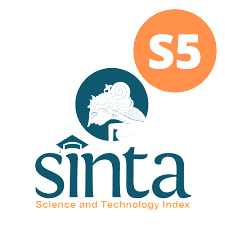EFEKTIVITAS PENGGUNAAN MEDIA PEMBELAJARAN DIGITAL PADA HASIL BELAJAR SISWA KELAS 5 SD N NAGRI KALER
DOI:
https://doi.org/10.33061/js.v7i1.8205Keywords:
learning media, learning outcomes, technology, effectivenessAbstract
Generations of the Nation is the hope of the state, services for Basic Education are the needs of the Indonesian people. This study aims to: 1) determine the effectiveness of digital learning media in improving student learning outcomes; 2) knowing students' knowledge before and after being given learning with digital learning media; 3) take advantage of advances in digital technology. On the other hand, this technological progress is very rapid and can be said to be a form of re-adaptation for teachers. The existence of Digital Learning media is a process to complement the needs of prospective generations to make it easier to learn, we cannot deny that when we are still using old learning media, children can get bored in learning. In short, we must take advantage of technological advances so that the demands of the nation's expectations can be fulfilled. Gols a teacher turns barren land into fertile land, the child is a layman who needs guidance and the teacher is a uswah who guides.
Keywords; Learning Media, Learning Outcomes, Technology, Effectiveness.
References
Angraini, T., Saragi, L. N. S., Jannah, M., & Sopian, M. (2017). Perubahan Paradigma Peran Guru Dalam Pembelajaran Era Digital. Prosiding Seminar Nasional 20 Program Pascasarjana Universitas PGRI Palembang 25 November 2017, November, 188–192.
Angraini, W. D. (2016). Analisis Faktor-Faktor yang Mempengaruhi Hasil Belajar Mata Pelajaran Ekonomi Kelas XI IIS SMA. Jurnal Pendidikan Dan Pembelajaran Khatulistiwa, 5(8), 1–11. https://repository.unsri.ac.id/27031/
Anis, I., Usman, J., & Arfah, S. R. (2021). Efektivitas Program Pelayanan Kolaborasi Administrasi Kependudukan di Dinas Kependudukan dan Pencatatan Sipil Kabupaten Gowa. E-Journal UNIMUS, 2, 3, 1105–1116.
Christian, Y. (2022). Rancangan Bangun Media Pembelajaran Pendidikan Bahasa Inggris Di SMAS Bodhi Dharma Batam Menggunakan Metode MDLC. 4, 1298–1301.
Damitri, D. E., & Adistana, G. A. Y. P. (2020). Keunggulan media powerpoint berbasis audio visual sebagai media presentasi terhadap hasil belajar siswa SMK teknik bangunan. Jurnal Kajian Pendidikan Teknik Bangunan, 06(02), 1–7. https://ejournal.unesa.ac.id/index.php/jurnal-kajian-ptb/article/view/36296
Elvira, E. (2021). Faktor Penyebab Rendahnya Kualitas Pendidikan dan Cara Mengatasinya (Studi pada : Sekolah Dasar di Desa Tonggolobibi). Iqra: Jurnal Ilmu Kependidikan Dan Keislaman, 16(2), 93–98. https://doi.org/10.56338/iqra.v16i2.1602
Faradila, S. P., & Aimah, S. (2018). Analisis Penggunaan Media Pembelajaran untuk Meningkatkan Minat Belajar Siswa di SMA N 15 Semarang. Prosiding Seminar Nasional Mahasiswa Unimus (Vol. 1, 2018, 1(2005), 508–512.
Hall, J., & Matthews, E. (2008). The Measurement of Progress and the Role of Education. European Journal of Education, 43(1), 11–22.
Lange, C., & Costley, J. (2020). Improving online video lectures: learning challenges created by media. International Journal of Educational Technology in Higher Education, 17(1). https://doi.org/10.1186/s41239-020-00190-6
Larlen. (2013). Persiapan Guru Bagi Proses Belajar Mengajar. Pena , 3(1), 81–91.
Lusiana, B., & Maryanti, R. (2020). The Effectiveness of Learning Media Used During Online Learning. Media Pendidikan, Gizi, Dan Kuliner, 9(2), 81–92. https://doi.org/10.17509/boga.v9i2.38379
Magdalena, I., Fatakhatus Shodikoh, A., Pebrianti, A. R., Jannah, A. W., Susilawati, I., & Tangerang, U. M. (2021). Pentingnya Media Pembelajaran Untuk Meningkatkan Minat Belajar Siswa Sdn Meruya Selatan 06 Pagi. EDISI : Jurnal Edukasi Dan Sains, 3(2), 312–325. https://ejournal.stitpn.ac.id/index.php/edisi
Marryono Jamun, Y. (2018). Dampak Teknologi Terhadap Pendidikan. Jurnal Pendidikan Dan Kebudayaan Missio, 10(1), 1–136.
Mustaqim, I. (2016). Pemanfaatan Augmented Reality Sebagai Media Pembelajaran. Jurnal Pendidikan Teknologi Dan Kejuruan, 13(2), 174–183. https://doi.org/10.1109/SIBIRCON.2010.5555154
Pulungan, A. H. (2021). The Use of Interactive Learning Media for Teachers in Rural Areas. Budapest International Research and Critics in Linguistics and Education (BirLE) Journal, 4(1), 524–532. https://doi.org/10.33258/birle.v4i1.1705
Putri, H. P., & Nurafni, N. (2021). Pengaruh Media Pembelajaran PowerPoint Interaktif terhadap Hasil Belajar IPS Siswa Sekolah Dasar. Edukatif : Jurnal Ilmu Pendidikan, 3(6), 3538–3543. https://doi.org/10.31004/edukatif.v3i6.986
Rahma, F. A., Harjono, H. S., & Sulistyo, U. (2023). Problematika Pemanfaatan Media Pembelajaran Berbasis Digital. Jurnal Basicedu, 7(1), 603–611.
Rahman, S. (2021). Pentingnya Motivasi Belajar Dalam Meningkatkan Hasil Belajar. PROSIDING SEMINAR NASIONAL PENDIDIKAN DASAR “Merdeka Belajar Dalam Menyambut Era Masyarakat 5.0,†November, 289–302.
Riyan, M. (2021). Penggunaan Media Pembelajaran Berbasis Android Pada Pembelajaran Teks Eksposisi. Diksi, 29(2), 205–216. https://doi.org/10.21831/diksi.v29i2.36614
Supartini, M. (2016). Pengaruh Penggunaan Media Pembelajaran Dan Kreativitas Guru Terhadap Prestasi Belajar Siswa Kelas Tinggi Di SDN Mangunharjo 3 Kecamatan Mayangan Kota Probolinggo. Jurnal Penelitian Dan Pendidikan IPS (JPPI), 10(2), 1858–4985. http://ejournal.unikama.ac.id/index.php/JPPI
Susanti, A., Kasim, U., Achmad, D., Burhansyah, B., & Nasir, C. (2022). The Use of Media in Innovative Learning to Improve Students’ Achievement in Learning English. Research in English and Education, 7(2), 85–90.
Syaparuddin, S., & Elihami, E. (2020). Peningkatan Motivasi Belajar Siswa Melalui Video pada Pembelajaran PKn di Sekolah Paket C. Jurnal Edukasi Nonformal, 1(1), 187–200.
Tafonao, T. (2018). Peranan Media Pembelajaran Dalam Meningkatkan Minat Belajar Mahasiswa. Jurnal Komunikasi Pendidikan, 2(2), 103. https://doi.org/10.32585/jkp.v2i2.113
Downloads
Published
Issue
Section
License
Copyright (c) 2023 Jurnal Sinektik

This work is licensed under a Creative Commons Attribution-NonCommercial 4.0 International License.
Authors who publish this journal agree to the following terms:
- Authors retain copyright and grant the journal right of first publication with the work simultaneously licensed under a Creative Commons Attribution License that allows others to share the work with an acknowledgement of the work's authorship and initial publication in this journal.
- Authors can separately make additional contractual arrangements for non-exclusive distribution published by the journal (e.g., publish it in a book), with an acknowledgement of its initial publication in this journal.
- Authors are allowed and encouraged to send their work via online (e.g., in the institutional repositories or their website) after published by the journal.














